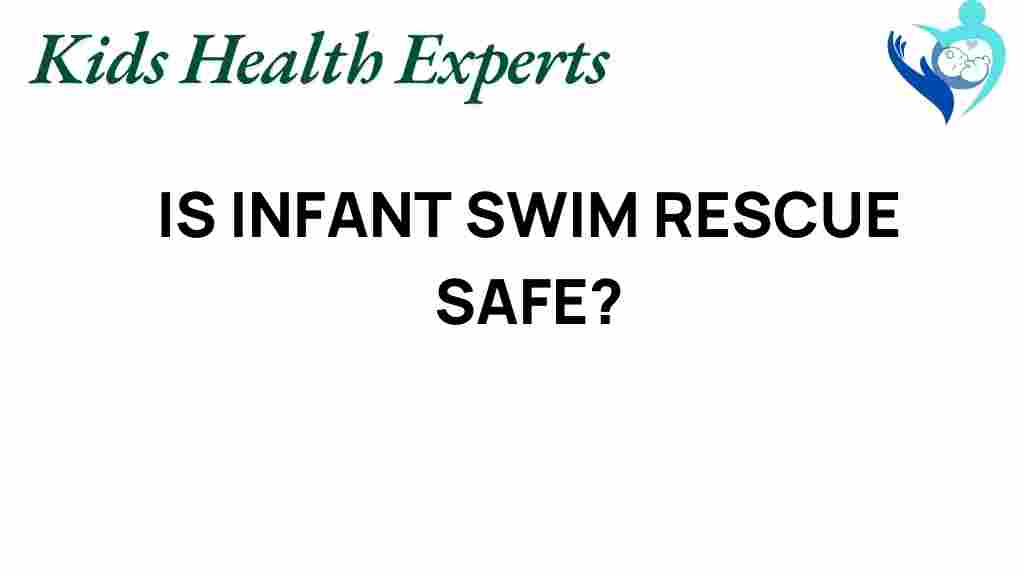Is Infant Swim Rescue Safe? Unpacking the Controversy
As parents, ensuring the safety of our children is always a top priority. Drowning is a leading cause of accidental death among children, and many parents are turning to infant swim rescue programs as a potential way to mitigate this risk. However, the debate surrounding these programs raises important questions about safety, effectiveness, and the right age for early swimming lessons. In this article, we will explore the details of infant swim rescue, assess its safety, and provide essential parenting advice on water safety and aquatic education.
Understanding Infant Swim Rescue
Infant swim rescue refers to specialized swimming programs designed to teach infants and young children how to respond in emergency situations when they find themselves in water. These programs typically include teaching children how to float, swim to safety, and roll onto their backs to breathe. While many parents advocate for these lessons, believing they enhance safety, others express concerns about their appropriateness and safety.
The Benefits of Infant Swim Rescue
Supporters of infant swim rescue highlight several benefits, including:
- Drowning Prevention: The primary goal of these programs is to reduce the risk of drowning by equipping children with survival skills.
- Increased Comfort in Water: Early exposure to water can help children become more comfortable and confident swimmers.
- Development of Aquatic Skills: Children learn essential skills such as floating, treading water, and swimming short distances.
Safety Concerns in Infant Swim Rescue
Despite the potential benefits, several safety concerns have been raised regarding infant swim rescue. Some of the key issues include:
- Physical Readiness: Critics argue that infants may not possess the physical ability to perform the techniques taught in these programs.
- Psychological Impact: For some children, the experience may be stressful, leading to a fear of water rather than comfort.
- Overconfidence: Parents may mistakenly believe their child is completely safe in water after completing a program, potentially leading to risky behaviors.
The Age Factor: When to Start Early Swimming Lessons
Determining the right age for early swimming lessons is crucial. While some programs start as early as six months, experts suggest considering the child’s physical and emotional readiness. Here are some guidelines to help you make an informed decision:
- Under 1 Year: At this age, lessons focus primarily on water acclimation and safety. The emphasis should be on having fun and getting comfortable in the water.
- 1 to 3 Years: This is often the ideal time to introduce basic swimming skills, including floating and simple swim techniques.
- 3 Years and Older: Children can start more structured swim lessons that include skills for safety and stroke development.
Making Informed Choices: Choosing a Program
When considering an infant swim rescue program, it is essential to do your research. Here are some tips for selecting the right program:
- Check Credentials: Ensure that the instructors are certified and have experience working with young children.
- Read Reviews: Look for testimonials from other parents who have enrolled their children in the program.
- Visit the Facility: Observing a class can give you insight into the program’s methods and safety measures.
- Ask About Safety Protocols: Inquire about how the program addresses safety and emergency situations.
Water Safety Tips for Parents
No matter what swimming program you choose, water safety should always be a priority. Here are some key tips for parents:
- Supervision: Always supervise children around water, even if they have had swimming lessons.
- Learn CPR: Knowing CPR can save lives in an emergency situation.
- Use Proper Safety Gear: Ensure that your child wears a life jacket in situations where they cannot swim.
- Teach Water Rules: Educate your child about the importance of staying away from pools and open water without adult supervision.
Troubleshooting Common Concerns
As you navigate the world of infant swim rescue and water safety, you may encounter some common concerns. Here are some troubleshooting tips:
- Fear of Water: If your child is fearful, take it slow. Focus on fun activities in the water before introducing lessons.
- Resistance to Lessons: Consider engaging with your child about their feelings. Sometimes, playing in the water together can ease their apprehension.
- Inconsistent Attendance: Consistency is key in learning. Try to maintain a regular schedule for lessons to help reinforce skills.
Conclusion: The Path to Safe Swimming
The safety of our children in and around water is paramount. While infant swim rescue programs offer valuable skills that may help reduce the risk of drowning, they should be approached with careful consideration. Parents should prioritize safety, stay informed about their child’s readiness, and choose programs that emphasize both skill development and emotional well-being.
Ultimately, fostering a positive and safe relationship with water through education, supervision, and fun can be the best way to ensure your child’s safety and enjoyment. For more resources on water safety and swimming lessons, check out this informative article on aquatic education.
By taking proactive steps and remaining engaged in your child’s aquatic education, you can help provide a foundation for a lifetime of safe swimming and enjoyment in the water.
This article is in the category Care and created by KidsHealthExperts Team
